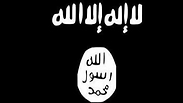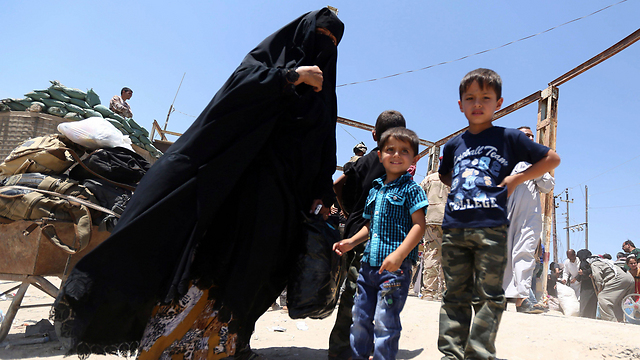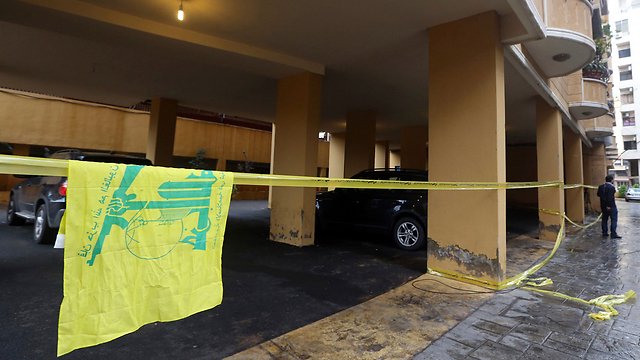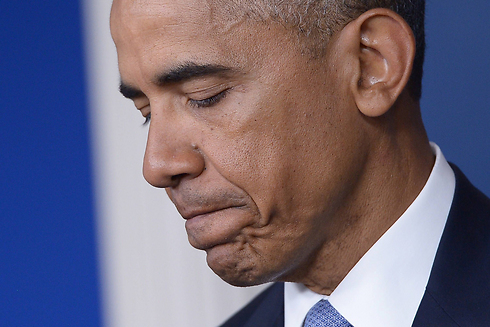
Why is the Islamic State undefeatable?
Analysis: Every ISIS commander killed in an airstrike has a deputy, 100 dead terror activists can be replaced with 100 new volunteers, and the radical Islamic organization is still making a lot of money from the oil fields it controls. The US-led coalition's failure to destroy the organization from the air calls for a massive ground offensive, but how can that be done without Iran's support?
In mid May, ISIS took over the key Iraqi city of Ramadi with an army of suicide bombers and car bombs.
The "black monster" versus the "yellow demons": The "black monster of the Muslim world is refusing to disappear. When one of its limbs is cut off, it grows another limb instead.
Hundreds of missiles and shells have been fired every week on lands controlled by ISIS, almost nine months since the establishment of the coalition against the Sunni terror organization. Who would have thought that the murderous organization would still be so strong in the summer of 2015?
This week, ISIS even succeeded in taking over the city of Ramadi and it currently controls large parts of the al-Anbar province, which borders on Jordan, Syria and Saudi Arabia. This is the organization's greatest achievement since conquering Mosul last year.
How is it possible? Are the countries involved in the war on terror really determined to destroy ISIS?
The wrong remedy
When a doctor recommends a wrong remedy for a serious illness, he may aggravate the problem. If it's a virus or a bug, it could develop immune methods against antibiotics which is too weak.
The American remedy for ISIS in the form of airstrikes has proved to be insufficient. A massive ground offensive is required. Every commander who has been killed has a deputy, and every 100 terror activists bombed by the coalition planes can be replaced with 100 new volunteers.
The incubation conditions of the ISIS disease are ideal too: Volunteer fighters are joining the Islamic State from the north through Turkey's open border, and for some reason the organization's propaganda is published through the internet uninterrupted. The coalition drove the ISIS forces away from certain areas, and the organization conquered other areas instead.
The economic war
According to American sources, many of ISIS' funding measures have been destroyed following the critical damage caused to the oil facilities in the areas controlled by the organization.
This week, the administration in Washington announced that a Delta Force raid on Syrian territory in the Deir al-Zour district killed the ISIS "oil minister," Abu Sayyaf, and his assistants. Such an operation can provide material for a Hollywood film such as "The Expendables 4," but it is unhelpful in the long run and ISIS will continue to sell oil.

The organization still controls the major oil fields in eastern Syria and northwestern Iraq. The ISIS moneymaking problem will not be solved before locating the groups in the Middle East that are buying the oil from the organizations and those which are transferring funds to the organization (some of them can probably be found in the countries which are part of the anti-ISIS coalition).
The Shiite problem
The key for understanding ISIS' survival is understanding the internal Muslim conflict between Sunnis and Shiites. The Iraqi and Syrian regimes, of Haider al-Abadi and Bashar Assad, rely on the help of Shiite militias. The Syrian regime has the help of Hezbollah and the Iraqi regime in al-Hashd al-Shaabi (the Popular Mobilization Forces). These two groups have flags with similar elements – a combination of a Kalashnikov rifle with the organization's name in Arabic on a yellow background.
The two Shiite groups have waged an all-out war against ISIS, but they are also hated by the local population, which is mostly Sunni. The Sunnis in eastern and northern Syria are suffering from ISIS' presence, but they are as hostile towards Hezbollah, which is considered the main support of the oppressing Alawite regime.

In western Iraq, the mostly-Sunni population is suffering from the ISIS regime, but hates the Popular Mobilization Forces – which only serves the Shiite interest in Iraq- just as much. The Popular Mobilization fighters have been accused of committing acts of revenge and abuse not just against ISIS prisoners, but also against the civil Sunni population.
Sunni leaders in the al-Anbar province and heads of Sunni tribes in the region have firmly refused to let the Shiite militia take part in the fight to free their lands. The Sunnis see the Shiite Popular Mobilization Forces as a threat which is as big as the Sunni ISIS.
A trick against the Sunnis?
The escape of the Ramadi commanders and the abandonment of the city's governmental institutions in light of the Islamic State threat are reminiscent of the abandonment of Mosul a year ago. It seems the commanders did not abandon their posts of their own accord, but received an intentional order to withdraw. It was likely Prime Minister al-Abadi's only way to force the Sunni tribe to agree to include the Shiite militias in the fighting.

Now, after Ramadi's fall and after the family members of the Sunni tribe leaders were taken hostage by ISIS, they have finally agreed to include the Popular Mobilization Forces in the fighting. The integration of the violent Shiite militias appears to deter not only the Sunnis, but also the leaders of the anti-ISIS coalition.
Iran is behind the scenes
The United States has a similar problem in Syria and Iraq. It is not interested in including Shiite elements which are directly supported by Iran in the war on ISIS, as there are no free gifts. The US will have to pay for the Iranian assistance with another compromise in the nuclear issue or compromise with Iran on the Shiite Houthi rebels in Yemen.
The Americans are also aware of the fact that Iran is standing behind the Lebanese Hezbollah and the Iraqi Popular Mobilization Forces and are not interested in including the Syrian army either in the anti-ISIS coalition. US President Barack is not interested in creating a precedent of an alliance with the axis of evil against the ISIS evil. He is determined to reinforce his allies' stance in the moderate Sunni axis – Saudi Arabia and the Gulf emirates, Jordan and Egypt.

The US is aware of the Turkish involvement in strengthening ISIS, and is turning a blind eye due to Turkey's importance to the Sunni axis. While the Iraqi army is subject to the control of a Shiite government in Iraq, the Americans are willing to help it and integrate the popular Mobilization Forces, as long as they are directly subjected to the Iraqi army and don't serve as a wing of the Iranian Revolutionary Guards.
A weak ISIS preferable to destroying ISIS?
The speed in which the Saudi army succeeded in curbing the Houthis' offensive in Yemen and in seriously affecting their power raises questions: Is ISIS more immune than the Houthis (which do not seem to outnumber them), although the coalition against them is much stronger than the Saudi coalition against their enemies in Yemen? Why are the Saudi coalition armies, some of which are part of the American coalition as well, showing much more determination in the Yemeni arena?
It's reasonable to assume that the concern among the Americans and the moderate Sunni axis is that pro-Iranian elements will take over the wide areas controlled by ISIS today.
The Sunni world's nightmare scenario includes a re-division of the Islamic State according to the Sykes-Picot borders between the Alawites and the Shiites in Syria and their Shiite Iraqi friends in the east. In as early as 2012, Shiite opposition organizations in both countries claimed that they were basically subject to an Iranian occupation.
No one will admit it, but is seems to be more convenient to leave ISIS and not destroy it as long as it doesn’t break through its current borders, so that it will continue to keep the Shiite militias busy in ongoing fighting which will waste their resources. In such a situation, the "black monster" will fight the Shiite "yellow demons," with the hopes that they will both wear each other out to death.
Dr. Yaron Friedman, Ynet's commentator on the Arab world, is a graduate of the Sorbonne. He teaches Arabic and lectures about Islam at the Technion, at Beit Hagefen and at the Galilee Academic College. His book, "The Nusayri Alawis: An Introduction to the Religion, History and Identity of the Leading Minority in Syria," was published in 2010 by Brill-Leiden.











